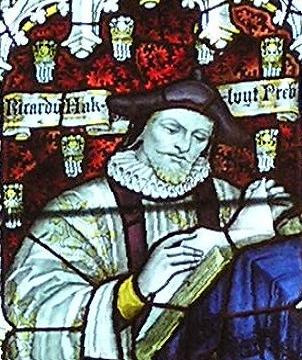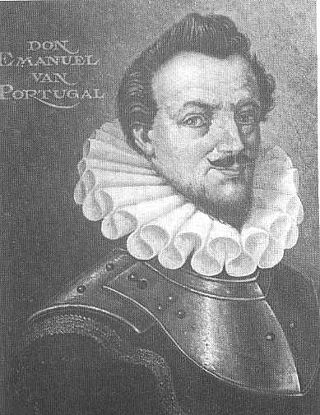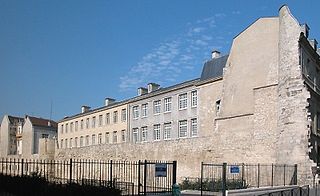
The Society of Jesus, also known as the Jesuit Order or the Jesuits, is a religious order of clerics regular of pontifical right for men in the Catholic Church headquartered in Rome. It was founded in 1540 by Ignatius of Loyola and six companions, with the approval of Pope Paul III. The society is engaged in evangelization and apostolic ministry in 112 nations. Jesuits work in education, research, and cultural pursuits. Jesuits also conduct retreats, minister in hospitals and parishes, sponsor direct social and humanitarian ministries, and promote ecumenical dialogue.

Richard Hakluyt was an English writer. He is known for promoting the English colonization of North America through his works, notably Divers Voyages Touching the Discoverie of America (1582) and The Principal Navigations, Voyages, Traffiques and Discoveries of the English Nation (1589–1600).
Martin Anton Delrio SJ was a Dutch Jesuit theologian. He studied at numerous institutions, receiving a master's degree in law from Salamanca in 1574. After a period of political service in the Spanish Netherlands, he became a Jesuit in 1580.
Sir Samuel Argall was an English adventurer and naval officer.
Thomas Fitzherbert was an English Jesuit.

The Lycée Charlemagne is located in the Marais quarter of the 4th arrondissement of Paris, the capital city of France.
The Collegium Germanicum et Hungaricum, or simply Collegium Germanicum, is a German-speaking seminary for Catholic priests in Rome, founded in 1552. Since 1580 its full name has been Pontificium Collegium Germanicum et Hungaricum de Urbe. It is located on the Via di San Nicola da Tolentino.

John de Pineda was a Spanish Jesuit theologian and exegete. He was a consultor to the Spanish Inquisition and nineteen printed works and six manuscripts of his writing are in existence.

The Reverend Father Gregory Martin was an English Catholic priest, a noted scholar of his time, academic and Doctor of Divinity, and served as the chief translator of the Rheims and Douai Version of the Bible, the first full, official Catholic English Bible translation, translated from the Latin Vulgate.

Luis de la Puente was a Spanish Jesuit theologian and ascetic writer. A few years after his death, the Sacred Congregation of Rites admitted the cause of his beatification and canonization.

Manuel of Portugal was the illegitimate son of António, Prior of Crato, pretender to the Portuguese throne during the 1580 Portuguese succession crisis. He secretly married in 1597 Countess Emilia of Nassau, daughter of William the Silent and Anna of Saxony.
The Islands Voyage, also known as the Essex-Raleigh Expedition, was an ambitious, but unsuccessful naval campaign sent by Queen Elizabeth I of England, and supported by the United Provinces, against the Spanish Empire and Portuguese Empire of Philip II from the House of Habsburg during the Anglo–Spanish War (1585–1604) and the Eighty Years' War.

Valerius Herberger was a German Lutheran preacher and theologian.

The Professed House was a Jesuit professed house in Paris, built on the rue Saint-Antoine in Le Marais. Its site between rue Saint-Paul, rue Saint-Antoine and rue Charlemagne are now occupied by the lycée Charlemagne. It welcomed theologians and scientists and was in a quarter lived in by the nobility. The église Saint-Louis was built nearby.
Louis Richeome (1544–1625) was a French Jesuit theologian and controversialist. He also wrote under the pseudonyms "Ludovicus de Beaumanoir", "Felix de la Grace", and "Franciscus Montanus".
François-Hyacinthe Choquet was a Dominican hagiographer and spiritual author in the Spanish Netherlands.

Jérôme Nadal, SJ was born on 11 August 1507 in Palma De Mallorca, in the Balearic Islands, Spain, and died on 3 April 1580 in Rome. He was a Spanish Jesuit priest in the first generation of the companions of St. Ignatius of Loyola. A very close collaborator of St. Ignatius of Loyola, the founder of the Society of Jesus, he was sent to explain to the various Jesuit communities of Europe the first draft of the Constitutions. He is known as the "Ignatian theologian" for having developed the theology behind Ignatian spirituality.
Fulvio Androzzi or Androzio (1523–1575) was an Italian Jesuit and author of devotional literature.
This page is based on this
Wikipedia article Text is available under the
CC BY-SA 4.0 license; additional terms may apply.
Images, videos and audio are available under their respective licenses.










